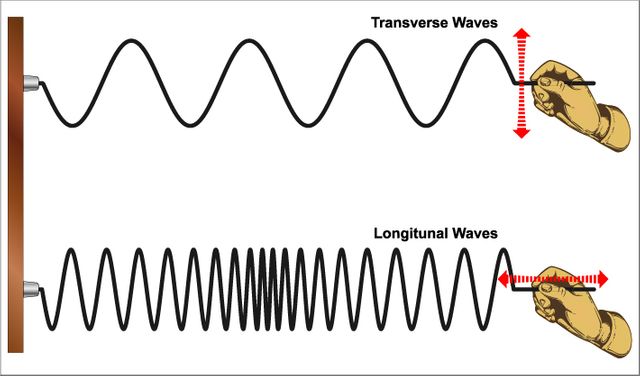1.6.3
Longitudinal & Transverse Waves
Transverse Waves
Transverse Waves
Here are some examples of transverse waves:


Moving springs
Moving springs
- Waving/moving the coils of a spring will make the coils move up and down as the wave passes.
- They then return to their original position after the wave has passed.
- This shows that a wave moves without transferring matter because the spring coils do not travel along with the wave.


Mexican wave
Mexican wave
- A “Mexican wave” at a sports event is an example of a transverse wave.
- The wave spreads around the stadium as the people stand up and sit down one after the other (at right angles to the direction of the people’s motion).


Corks bobbing
Corks bobbing
- A cork bobbing on the water shows how a transverse wave works.
Longitudinal Waves
Longitudinal Waves
Here are some example of longitudinal waves:


Pulling & pushing springs
Pulling & pushing springs
- Pushing the spring in and out (compressing and extending), longitudinal waves are created.
- The coils and the wave move along the same line.


Sound waves
Sound waves
- Sound waves are longitudinal waves.


P-waves
P-waves
- P-waves are pressure waves created during earthquakes.
- They are longitudinal waves.
Electromagnetic Waves
Electromagnetic Waves
All electromagnetic waves are transverse and travel at the same speed.


Transverse
Transverse
- All electromagnetic waves are transverse waves.
- The electric and magnetic fields oscillate perpendicular to the direction of energy propagation.
- All electromagnetic waves travel at the speed of light, c, in a vacuum.
- The speed of light is c = 3 x 108 m/s.
1Principles of Science I
1.1Structure & Bonding
1.1.1Atomic Model
1.1.2Electron Shells, Sub-Shells & Orbitals
1.1.3Ionic Bonding
1.1.4Representing Ionic Bonds
1.1.5Covalent Bonding
1.1.6Representing Covalent Bonds
1.1.7Metallic Bonding
1.1.8Intermolecular Forces
1.1.9Intermolecular Forces 2
1.1.10End of Topic Test - Bonding
1.1.11Relative Masses
1.1.12The Mole
1.1.13Molar Calculations
1.1.14Molar Calculations 2
1.1.15Empirical & Molecular Formulae
1.1.16Balanced Equations
1.1.17Percentage Yield
1.1.18End of Topic Test - Amount of Substance
1.2Properties of Substances
1.2.1The Periodic Table
1.2.2Ionisation Energy
1.2.3Factors Affecting Ionisation Energies
1.2.4Trends of Ionisation
1.2.5Trends in the Periodic Table
1.2.6Polarity
1.2.7Metals & Non-Metals
1.2.8Alkali Metals
1.2.9Alkaline Earth Metals
1.2.10Reactivity of Alkaline Earth Metals
1.2.11Redox
1.2.12Transition Metals
1.2.13Redox Reactions of Transition Metals
1.3Cell Structure & Function
1.4Cell Specialisation
1.5Tissue Structure & Function
1.5.1Human Gas Exchange
1.5.2Blood Vessels
1.5.3Atherosclerosis
1.5.4Skeletal Muscle
1.5.5Slow & Fast Twitch Fibres
1.5.6Neurones
1.5.7Speed of Transmission
1.5.8Action Potentials
1.5.9End of Topic Test - Neurones & Action Potentials
1.5.10Synapses
1.5.11Types of Synapse
1.5.12Medical Application
1.5.13End of Topic Test - Synapses
1.5.14Chemical Brain Imbalances
1.5.15Effect of Drugs on the Brain
1.6Working with Waves
1.7Waves in Communication
2Practical Scientific Procedures and Techniques
3Science Investigation Skills
3.1Scientific Processes
3.2Data Handling & Analysis
3.3Enzymes in Action
3.4Diffusion
3.5Plants & Their Environment
3.6Energy Content in Fuels
4Principles of Science II
4.1Extracting Elements
4.2Relating Properties to use of Substances
4.3Organic Chemistry
4.4Energy Changes in Industry
4.5The Circulatory System
4.5.1The Circulatory System
4.5.2Blood Vessels
4.5.3Blood Transfusion & the ABO Rhesus System
4.5.4The Heart
4.5.5The Cardiac Cycle
4.5.6Cardiac Output
4.5.7Coordination of Heart Action
4.5.8Heart Dissection
4.5.9Controlling Heart Rate
4.5.10Electrocardiograms
4.5.11Cardiovascular Disease
4.5.12Investigating Heart Rates
4.6Ventilation & Gas Exchange
4.7Urinary System
4.9Thermal Physics
4.9.1Power & Efficiency
4.9.2Work & Energy
4.9.3Conservation of Energy
4.9.4Pressure
4.9.5First Law of Thermodynamics
4.9.6Second Law of Thermodynamics
4.9.7Heat Engines, Heat Pumps & Refrigerators
4.9.8Non-Flow Processes
4.9.9p-V Diagrams
4.9.10Ideal Gases
4.9.11Ideal Gases 2
4.9.12Thermal Energy Transfer
4.9.13Thermal Energy Transfer Experiments
4.10Materials
5Contemporary Issues in Science
5.1Contemporary Issues in Science
5.2Analysing Scientific Information
Jump to other topics
1Principles of Science I
1.1Structure & Bonding
1.1.1Atomic Model
1.1.2Electron Shells, Sub-Shells & Orbitals
1.1.3Ionic Bonding
1.1.4Representing Ionic Bonds
1.1.5Covalent Bonding
1.1.6Representing Covalent Bonds
1.1.7Metallic Bonding
1.1.8Intermolecular Forces
1.1.9Intermolecular Forces 2
1.1.10End of Topic Test - Bonding
1.1.11Relative Masses
1.1.12The Mole
1.1.13Molar Calculations
1.1.14Molar Calculations 2
1.1.15Empirical & Molecular Formulae
1.1.16Balanced Equations
1.1.17Percentage Yield
1.1.18End of Topic Test - Amount of Substance
1.2Properties of Substances
1.2.1The Periodic Table
1.2.2Ionisation Energy
1.2.3Factors Affecting Ionisation Energies
1.2.4Trends of Ionisation
1.2.5Trends in the Periodic Table
1.2.6Polarity
1.2.7Metals & Non-Metals
1.2.8Alkali Metals
1.2.9Alkaline Earth Metals
1.2.10Reactivity of Alkaline Earth Metals
1.2.11Redox
1.2.12Transition Metals
1.2.13Redox Reactions of Transition Metals
1.3Cell Structure & Function
1.4Cell Specialisation
1.5Tissue Structure & Function
1.5.1Human Gas Exchange
1.5.2Blood Vessels
1.5.3Atherosclerosis
1.5.4Skeletal Muscle
1.5.5Slow & Fast Twitch Fibres
1.5.6Neurones
1.5.7Speed of Transmission
1.5.8Action Potentials
1.5.9End of Topic Test - Neurones & Action Potentials
1.5.10Synapses
1.5.11Types of Synapse
1.5.12Medical Application
1.5.13End of Topic Test - Synapses
1.5.14Chemical Brain Imbalances
1.5.15Effect of Drugs on the Brain
1.6Working with Waves
1.7Waves in Communication
2Practical Scientific Procedures and Techniques
3Science Investigation Skills
3.1Scientific Processes
3.2Data Handling & Analysis
3.3Enzymes in Action
3.4Diffusion
3.5Plants & Their Environment
3.6Energy Content in Fuels
4Principles of Science II
4.1Extracting Elements
4.2Relating Properties to use of Substances
4.3Organic Chemistry
4.4Energy Changes in Industry
4.5The Circulatory System
4.5.1The Circulatory System
4.5.2Blood Vessels
4.5.3Blood Transfusion & the ABO Rhesus System
4.5.4The Heart
4.5.5The Cardiac Cycle
4.5.6Cardiac Output
4.5.7Coordination of Heart Action
4.5.8Heart Dissection
4.5.9Controlling Heart Rate
4.5.10Electrocardiograms
4.5.11Cardiovascular Disease
4.5.12Investigating Heart Rates
4.6Ventilation & Gas Exchange
4.7Urinary System
4.9Thermal Physics
4.9.1Power & Efficiency
4.9.2Work & Energy
4.9.3Conservation of Energy
4.9.4Pressure
4.9.5First Law of Thermodynamics
4.9.6Second Law of Thermodynamics
4.9.7Heat Engines, Heat Pumps & Refrigerators
4.9.8Non-Flow Processes
4.9.9p-V Diagrams
4.9.10Ideal Gases
4.9.11Ideal Gases 2
4.9.12Thermal Energy Transfer
4.9.13Thermal Energy Transfer Experiments
4.10Materials
5Contemporary Issues in Science
5.1Contemporary Issues in Science
5.2Analysing Scientific Information
Unlock your full potential with Seneca Premium
Unlimited access to 10,000+ open-ended exam questions
Mini-mock exams based on your study history
Unlock 800+ premium courses & e-books